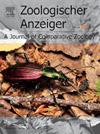1936年schmitti Burkenroad对虾和1931年vanannamei Boone对虾第二性性状的个体发生特征(十足目:对虾科)
IF 1.5
3区 生物学
Q2 ZOOLOGY
引用次数: 0
摘要
第二性特征是对虾分类学研究中常用的一种方法,因为第二性特征是对虾的主要特征。然而,关于这些结构的个体发育的研究很少,而且大多只描述了一个单一的发育阶段。这些结构的个体发生比较可能对准确评估南大西洋中西部外来物种凡纳滨对虾(Penaeus vannamei)的生物入侵过程特别有用,因为在幼年阶段很难将其与自然同系物施米蒂对虾(Penaeus schmitti)区分出来。为了填补这一空白,我们沿着个体发生的方向描述了凡纳梅和施米蒂的第二性征形态。我们证实了这些结构在不同个体发生阶段的有效性。我们的研究结果表明,幼虾的第二性特征结构与成虾的第二性特征结构不同,但尽管如此,鞘层和足部的一系列特征使得所研究的物种在不同的个体发育阶段之间得到了成功的区分。我们的研究结果也支持了内胚芽融合可能不是雄性性形态发育的最后一步的假设。本研究有助于评估美洲大西洋沿岸凡纳滨鹬的建立过程,这是监测和控制外来物种传播的关键步骤。本研究结果可为对虾生殖生物学和发育的进一步研究奠定基础。本文章由计算机程序翻译,如有差异,请以英文原文为准。
Ontogenetic characterization of the secondary sexual characters of Penaeus schmitti Burkenroad, 1936 and Penaeus vannamei Boone, 1931 (Decapoda: Penaeidae)
Secondary sexual characters are commonly used in taxonomic studies of penaeid shrimp, as these structures are the main distinguishing features between species. However, there are few studies on the ontogenetic development of these structures, and most of them describe only a single developmental stage. The ontogenetic comparison of these structures may be particularly useful for accurately assessing the biological invasion process of the exotic species Penaeus vannamei in the central-western South Atlantic, given the difficulty of distinguishing it from its natural congener Penaeus schmitti at juvenile stages. To fill this gap, here we describe the morphology of secondary sexual characters in P. vannamei and P. schmitti along the ontogeny. We confirmed the efficiency of these structures to discriminate them at different ontogenetic stages. Our results show that the structures of secondary sexual characters in juvenile shrimp are different from those in adults, but nevertheless, sets of characters in both the thelycum and the petasma allow a successful distinction between the studied species at different ontogenetic stages. Our results also support the hypothesis that endopodite fusion may not be the final step in male sexual morphological development. Our research may facilitate the assessment of the establishment process of P. vannamei along the American Atlantic coastline, a critical step in monitoring and controlling the spread of alien species. In addition, these results may serve as a baseline for future studies on the reproductive biology and development of penaeid shrimp.
求助全文
通过发布文献求助,成功后即可免费获取论文全文。
去求助
来源期刊

Zoologischer Anzeiger
生物-动物学
CiteScore
2.80
自引率
7.10%
发文量
75
审稿时长
>12 weeks
期刊介绍:
Zoologischer Anzeiger - A Journal of Comparative Zoology is devoted to comparative zoology with a special emphasis on morphology, systematics, biogeography, and evolutionary biology targeting all metazoans, both modern and extinct. We also consider taxonomic submissions addressing a broader systematic and/or evolutionary context. The overall aim of the journal is to contribute to our understanding of the organismic world from an evolutionary perspective.
The journal Zoologischer Anzeiger invites suggestions for special issues. Interested parties may contact one of the editors.
 求助内容:
求助内容: 应助结果提醒方式:
应助结果提醒方式:


